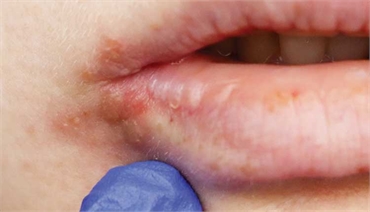Can I have a dental filling done if I've got a cold sore?
July 17, 2023

Cold sore, due to herpes simplex virus is one of the most commonly occurring viral infections in children till 12 years of age. It targets the orofacial tissues primarily and the virus clings on to a sensory nerve and remains latent there until an external trigger reactivates it and initiates a reinfection. This second wave of infection is likely to be seen during adolescence.
The herpes simplex virus first manifests itself in the form of a papule following a phase of fever, malaise and fatigue. It then gradually becomes a vesicle filled with infectious liquid. Finally, a full blown lesion is formed which will take at least two weeks to heal. These signs and symptoms are more severe during the primary infection and less severe in the phase when the recurrence occurs. Recurrence is seen in nearly 40% of the cases. Researchers also postulate, that in some other cases, the reinfection is triggered but certain cells of the body cause an immunological reaction that suppresses the clinical symptoms.
Apart from the detrimental effects it has on the one infected with it, herpes simplex virus can easily be transmitted to the ones surrounding or are directly in touch with the infected person. For example, dentists who come in contact with patients infected with herpes simplex, are at a high risk of getting infected that can cause herpetic whitlow (affecting the thumbs) or ophthalmic keratitis (affecting the cornea).
The most frequently encountered form of herpetic infection that can be encountered in a dental clinic is herpetic labialis. It primarily affects the lips and transmission of the virus to the dental surgeons fingers or thumbs or through aerosol generation is highly likely. Clinical guidelines and recommendations suggest that dental surgeons should ideally avoid any treatment until the lesion heals. If at all an emergency procedure is needed, then it should be carried only after wearing personal protective equipment (PPE). These include full sleeve lab coat, goggles and face shield.
Even though the prevalence is noteworthy, transmission of infection to the dental staff may not always occur. One of the ways to prevent this is by prescribing the patient antiviral medications like valacyclovir before the procedure which can help in decreasing the chances of the virus' activation. Acyclovir and penicyclovir are two antiviral drugs that can also be used by the patient as topical agents. These are applied during the active stage of the lesion to regress the lesion and accelerate healing. In patients who are immunocompromised and resistant to acyclovir, then cidovir and foscarnet can be used. During the earlier stages of the lesion, docasonal application five times a day has been proven to be effective.
A dental filling is usually not considered an emergency treatment especially if the patient has an active herpes lesion. Hence, treatment should be deferred as a filling procedure generates a lot of aerosols and transmission of the virus through saliva is a possibility. Moreover, the use of airotors generates heat, which can be one of the triggers for reactivation of the virus. The stretching of tissues during the procedures itself can be a trigger for intraoral lesions due to herpetic virus. Any unintentional injury during the procedure can cause the herpes simplex virus on the sensory nerve to migrate down to the lips, buccal mucosa and other oral tissues.
Apart from airotors, even lasers are used for removing carious lesions. However, these radiations can also activate the dormant virus and subsequently the lesion. Some filling o restorative procedures need to be done in carious lesions that are relatively deeper. In these cases, the dental surgeon might have to first numb the tooth. However, since these are injected near the plexus or nerves, it once again becomes a risk factor for the herpes simplex virus activation.
Depending on the stage at which the active lesions is present, past history of herpetic lesion and site of the current herpetic lesion, a patient should be assessed and scheduled for a restorative treatment with dental fillings. It is recommended to schedule after two weeks in case the patient presents with an active lesion. It is also recommended that dentists follow the protocols of using protective equipment, use equipment with minimal aerosol generation and avoid any Iatrogenic injuries once the patient comes for restorative treatment.

